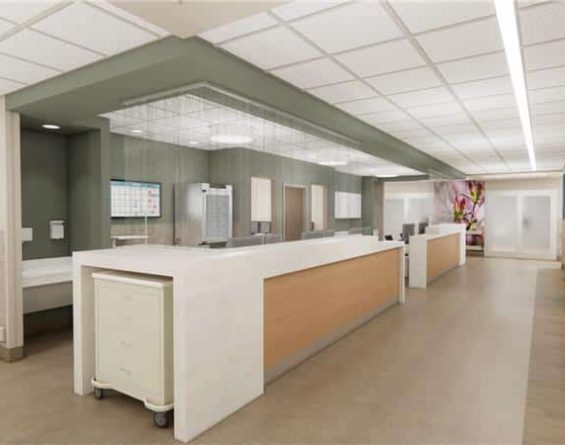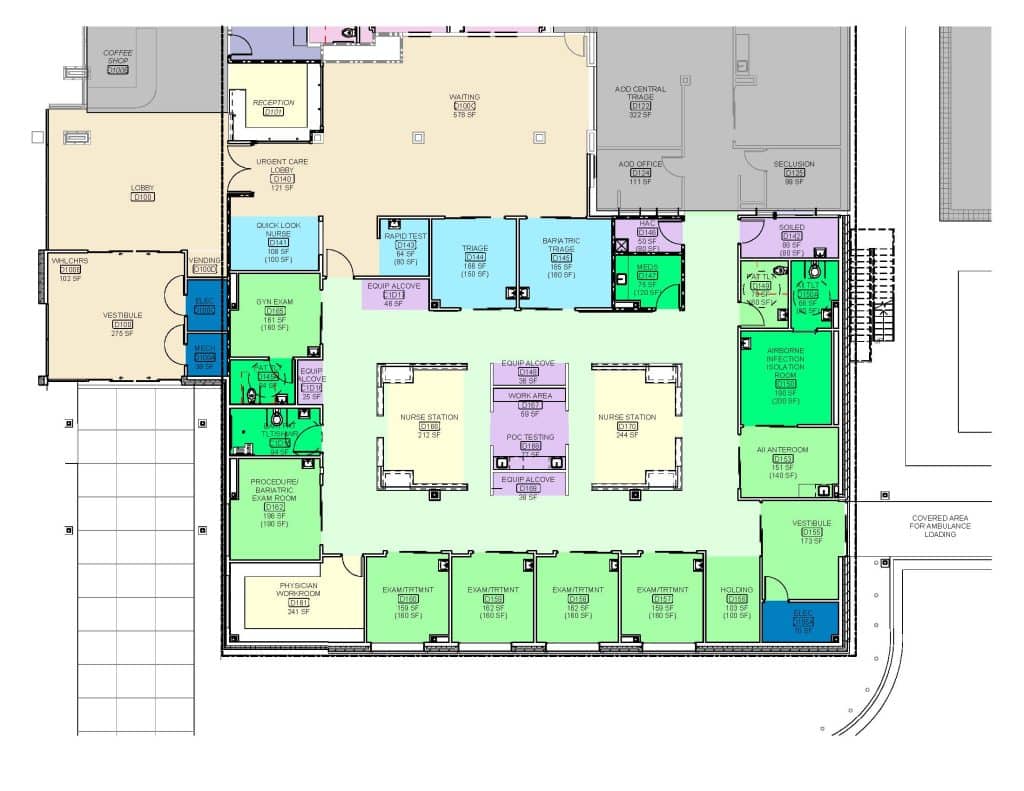Balancing Collaboration and Accountability: How Construction Administration Protects Healthcare Projects in the Nation’s Most Complex Environments
December 15, 2025

Healthcare workers face a growing risk of workplace violence. As architects and engineers, it is important for us to consider how certain design decisions may impact the safety and well-being of staff in an urgent care setting. A thoughtful design proactively addresses potential hazards while supporting staff workflow and patient care. The following are a few items to consider while designing an urgent care suite.
Controlling Access and Zoned Areas
An urgent care suite should be divided into public, clinical, and staff-only zones. This arrangement will maximize staff safety by limiting patient access to sensitive areas, reducing risk of theft (such as medications), and minimizing the chance of violence. Public zones include waiting areas, reception, and restrooms. Clinical zones include patient exam rooms, triage, and support areas such as imaging and labs that are accessible only to staff and patients under supervision. Staff zones include staff break areas, lockers, offices, medication storage and utility spaces that only staff should have access to. Locating the staff entrance away from the patient entrance and circulation will prevent patients or visitors from entering staff zones which will reduce the risk of confrontations or intrusions. The staff entrance should also be near a secure parking area and equipped with access control. Placing medication rooms centrally within the staff-only zone and including access control on the doors will help protect staff from confrontations related to controlled substances.
Visibility and Open Sightlines
Designing the reception desk to face the waiting area with clear sightlines to the entrance and triage area allows staff to monitor patient behavior and detect potential threats early. Arranging the exam rooms around a central nurse station will provide maximum visibility. Including view windows in triage and exam room doors or walls will enable staff to observe situations from outside and seek help if a patient becomes aggressive. Apogee put these concepts into practice during the design of the urgent care addition at the Spokane VA Medical Center. In this design, exam and triage rooms are efficiently grouped around a central nurse station, providing maximum visibility.

Circulation and Flow
Creating distinct corridors for staff and patients can minimize unintended interactions and reduce the chance of staff encountering agitated patients in hallways. Providing multiple exit routes will prevent staff from being trapped during a confrontation. Grouping the exam rooms near the triage area and nursing station will minimize staff travel time and ensure quick access to support. Apogee used this approach during the recent design of an urgent care remodel for the Prescott VA Medical Center. The urgent care suite has a separate “back exit” to the exterior, which can be used as a safety exit for staff in the event of an emergency.
De-escalation and Safe Spaces
The goal of the intake process is to place the patient in the most supportive and appropriate place for an assessment, which is typically in the first look and triage area. An alternate location for initial assessment is in a Mental Health Intervention Room. Providing a dedicated de-escalation room for managing agitated or behavioral health patients can help to calm them, thereby reducing the risk of violence towards staff. Providing two exits from this de-escalation room will prevent entrapment of staff during an emergency. If space is limited, consider designing the Mental Health Exam/Treatment rooms to double as Intervention rooms. In this case, providing sliding anti-ligature inside the room to conceal sinks, supply carts and medical gases will increase safety for patients at risk of self-harm. This is the approach that Apogee recommended during the design of the Urgent care addition at the Spokane VA Medical Center. Designing an alcove with an observation window adjacent to these mental health treatment rooms will allow staff to monitor the patient without being in the room itself. A seclusion/restraint room may also be added to the urgent care suite if space allows. Also, providing a secure staff breakroom with panic buttons will give staff a retreat space during violent incidents or security breaches.
Emergency Egress and Safety
Providing multiple, clearly marked emergency exits will allow staff to evacuate quickly during fires, active shooter events, or other emergencies. Positioning exits to avoid funneling staff through public areas during evacuation will allow staff to evacuate quickly. Placing fire extinguishers, AEDs, and first-aid kits in easily accessible but secure locations will enable rapid response to medical or environmental emergencies without compromising staff safety.
Infection Control
Strategies to reduce the spread of infectious diseases include locating handwashing sinks or sanitizer stations near exam room entrances and exits, which encourage staff hygiene without disrupting workflow. A dedicated negative pressure isolation room is typically required within an urgent care suite. If space allows, consider having a separate entrance from triage area into the isolation room, to avoid cross-contamination. Urgent care waiting rooms have specific air change requirements to protect patients, visitors, and staff from airborne contagious diseases.
Safe Patient Handling and Mobility
Providing ceiling-mounted patient lift systems in exam/treatment areas will minimize the instances of healthcare occupational injury for staff. The design of each room should include enough space to facilitate safe patient transfers.
Lighting
Providing bright, even lighting in hallways, parking lots, and entrances will eliminate dark corners where threats could hide and may deter potential aggressors. Generous use of exterior windows to allow natural light in waiting and staff areas will also increase staff well-being.
Security and Technology Integration
Having a security staff or police presence at the entrances to Urgent Care suites will also enhance staff safety and can be achieved with either an open station/desk or a glass-enclosed room. If an enclosed room is provided, consider having two ways to enter/exit the room. Locating the security station near the triage room will allow for observation of the first interactions between patients and staff. Consider providing a video monitor in the vestibule so people entering can see themselves on the monitor, which may also help to prevent violent behavior. Providing a walk-through metal detector in the vestibule for patient and visitor screening will also enhance the safety of staff and deter potential threats. Locating panic buttons at the reception desk, in exam rooms, and in triage areas will also support safety for staff. Locating CCTV cameras at key points like entrance vestibules, waiting area, and hallways will increase staff safety as well. Intercoms or two-way communication devices in exam rooms and staff areas can provide staff with a means for rapid communication during a crisis.
In conclusion, considering these items during design will provide a layout that proactively addresses potential hazards while supporting staff workflow and patient care.